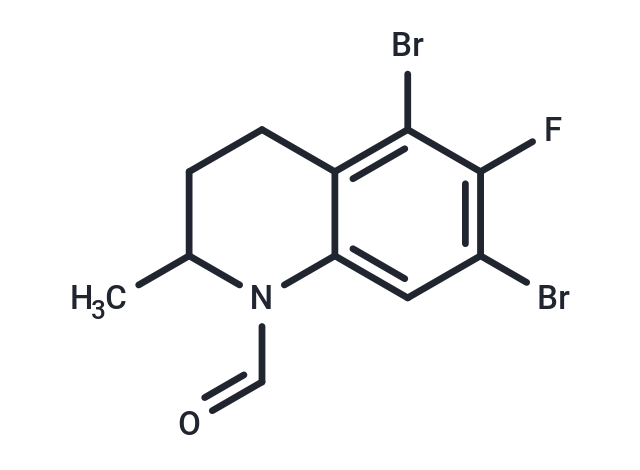Shopping Cart
- Remove All
 Your shopping cart is currently empty
Your shopping cart is currently empty

CE3F4 is a selective antagonist of exchange protein directly activated by cAMP (Epac1; IC50s of 10.7 μM and 66 μM for Epac1 and Epac2(B), respectively).

| Pack Size | Price | Availability | Quantity |
|---|---|---|---|
| 5 mg | $47 | In Stock | |
| 10 mg | $80 | In Stock | |
| 25 mg | $156 | In Stock | |
| 50 mg | $288 | In Stock | |
| 1 mL x 10 mM (in DMSO) | $52 | In Stock |
| Description | CE3F4 is a selective antagonist of exchange protein directly activated by cAMP (Epac1; IC50s of 10.7 μM and 66 μM for Epac1 and Epac2(B), respectively). |
| Targets&IC50 | EPAC2B:66 μM, EPAC1:10.7 μM |
| In vitro | CE3F4 acts as a selective antagonist of the Epac1, demonstrating inhibitory concentrations (IC50) of 10.7 μM for Epac1 and 66 μM for Epac2(B), illustrating greater potency against Epac1 as compared to its (S)-stereoisomer ((S)-CE3F4, IC50, 56 μM), yet showing lesser activity than its (R)-stereoisomer ((R)-CE3F4, IC50, 5.8 μM). At a concentration of 20 μM, CE3F4 effectively inhibits Epac-induced Rap1 activation in HEK293 cells and significantly reduces the late-phase ERK activation prompted by glucose in INS-1 cells. Moreover, at 40 μM, it specifically targets Epac1's guanine nucleotide exchange activity without disturbing Rap1's function or the Epac1-Rap1 interaction. CE3F4 at a 50 μM concentration exhibits stronger inhibitory effects on the guanine nucleotide exchange factor (GEF) activity of Epac1 compared to both forms of Epac2. It also inhibits the Epac1 exchange activity induced by compound 007, with an IC50 of 23 ± 3 μM, while not affecting PKA activity. |
| Molecular Weight | 351.01 |
| Formula | C11H10Br2FNO |
| Cas No. | 143703-25-7 |
| Smiles | CC1CCc2c(Br)c(F)c(Br)cc2N1C=O |
| Relative Density. | no data available |
| Storage | Powder: -20°C for 3 years | In solvent: -80°C for 1 year | Shipping with blue ice. | |||||||||||||||||||||||||||||||||||
| Solubility Information | DMSO: 50 mg/mL (142.45 mM), Sonication is recommended. | |||||||||||||||||||||||||||||||||||
Solution Preparation Table | ||||||||||||||||||||||||||||||||||||
DMSO
| ||||||||||||||||||||||||||||||||||||

Copyright © 2015-2025 TargetMol Chemicals Inc. All Rights Reserved.